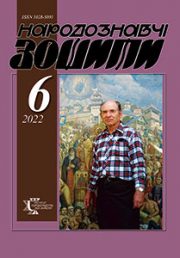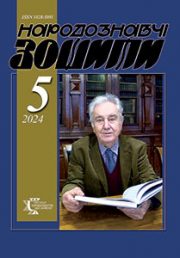The Ethnology Notebooks. 2018, 1 (139), 179–188
UDK7.04:2.67 (477.84)
DOI https://doi.org/10.15407/nz2018.01.179
Received 4.01.2018
Levytska Mariana, Candidate of Sciences in Art Studies,
Ph.D, doctoral student in the Department
of the Institute of Ethnology
of the National Academy of Sciences of Ukraine.
Svobody Avenue 15, 79000, Lviv, Ukraine.
Contacts: e-mail: m.levytska@gmail.com
Abstract. Example of the Assumption cathedral of the Pochayiv Monastery has shown the changes in the church interior decoration after the monastery transition from Basilian Order to the Russian Orthodox Church in 1831. These changes were accomplished in accordance with a political needs. One of this needs was a purpose to sacralize a tzar authority and it has been realized by the «Sacred Rus’ «concept. Authority used different resources to establish a loyalty of a new subjected, such as religious art within a church interior (icons, mural paintings, lithurgical items) and new objects of the worship (new Russian saints). These visual components in the ritual space reinforce its influence. Therefore, the image of Christ, the Virgin, the Apostles or Evangelists combined space with images of the new saints inscribed in the historical context of Russian Orthodoxy.
Keywords: Pochayiv Monastery, Assumption cathedral, religious art, Sacred Rus’ concept.
REFERENCES
Bazen, Zh. (2001). Barokko i rokoko. Moskva: Slovo.
Hobsbaum, E., Rejndzher, T. (Eds.). (2010). Vynajdennia tradytsii. Kyiv: Nika-Tsentr. P. 11–12.
Dva dokumenta po delu peredachi Pochaevskoj Lavry iz vedenija uniatov v vedom-stvo pravoslavnoe. Kievskaja Starina. 1882. P. 486–502.
Isaievych, Ya. (2011). Knyhovydannia i drukarstvo v Pochaievi: initsiatory ta vykonavtsi. Kyiv: Natsional’na b-ka Ukrainy im. V. Vernads’koho; Drukarnia Pochaivs’koho Uspens’koho monastyria ta ii starodruky. P. 7–22.
Kashuba, M.V. (2005). Iov Pochaivs’kyj. Entsyklopediia istorii Ukrainy: u 10 t. (T. 3). Kyiv: Naukova dumka. P. 530.
Boguslavskij, V.V. (Ed.). (2004). Karamzin Nikolaj. Slavjanskaja jenciklopedija: XVII vek: v 2-h t. (T. 1). Moskva: Olma-Press. P. 301.
Kobryn, M. (2012). Zamojs’kyj synod i formuvannia tradytsijnoi identychnosti UHKTs. Visnyk LNU. Vyp. 15. P. 234–242.
Los’, V. (2005). Pytannia vplyviv uniats’koi tradytsii na dukhovne zhyttia ukrains’koho naselennia: postanovka problemy (Pravoberezhna Ukraina v seredyni KhIKh st.). Istoriia relihij v Ukraini. Naukovyj schorichnyk. L’viv: Lohos. P. 353–359.
Mytropolyt Ilarion [Ivan Ohiienko] (1961). Fortetsia pravoslav’ia na Volyni – Sviata Pochaivs’ka Lavra. Tserkovno-istorychna monohrafiia. Vinnipeh.
Pljuhanova, M. (1995). Sjuzhety i simvoly Moskovskogo carstva. Sankt-Peterburg: Akropol’.
Rychkov, P., Luts, V. (2004). Pochaivs’ka Sviato-Uspens’ka Lavra. Kyiv.
Smolij, V.A. (1997). Deiaki pytannia sotsial’noi ta konfesijnoi polityky Rosii na Pravoberezhnij Ukraini v kintsi XVIII st. Kam’ianets’-Podil’s’kyj.
Smirnov, V. (2008). Pamjatnik gosudarstva Rossijskogo. Tysjacheletie v bronze.
Strel’cova, A. (2016). Interv’ju s A. Lidovym. «Vizantija posle Vizantii». Iskusstvo. № 2.
Sokolov, N.M. (1903). Svjatye Zemli Russkoj: K dvuhsotletnej godovshhine so dnja konchiny Sv. Mitrofana Voronezhskogo. Sankt-Peterburg.
Tarnavskij, A. (1883). Po povodu 50-letnego jubileja Pochaevskoj. Kіevskaja Starina. № 12.
Hojnackij, A.F. (1897). Pochaevskaja Uspenskaja Lavra. Istoricheskoe opisanie. Pochaev.
Ukrains’ka shliakhta z kintsia XIV do seredyny XVII stolittia. Volyn’ i Tsentral’na Ukraina. Kyiv, 1993.
Berezhnaya, L. (2013). Kloster Pocajiv. Religiose Errinerungsorte in Ostmitteleuropa. Konstitution and Konkurrenz im nationen- und epochenubegreifenden Zugriff. Berlin: DE GRUYTER. S. 37–51.
Himka, J.P. (1999). Religion, and Nationality in Western Ukraine. The Greek Catholic Church and the Ruthenian National Movement in Galicia 1867–1900. McGill-Queen’s University Press. Montreal; Kingston; London; Ithaka.
Lang, W.K. (2003). Das heilige Russland: Geschichte, Folklore, Religion in der russischen Malerei des 19. Jahrhunderts: Reimer.
Plokhiy, S. (2015). The Missing Skeleton: Understanding the Identities of Kuivan Rus. Religion, State, Society and Identity in Transition Ukraine. WPL. S. 19–32.
Putna, M.C. (2015). Obrazy z kulturních dějinruské religiozity. Praha: Vyšegrad.
Skinner, В. (2005). Borderlands of Faith: Reconsidering the Origins of a Ukrainian Tragedy. Slavic Review. Vol. 64. № 1. P. 88–116.
Tschizewskij, D. (1959). Das Heilige RuЯland: Russische Geistesgeschichte, 2 Bдnde. Hamburg: Rowohlt Taschenbuch Verlag.
Wolff, L. «The Uniate Church and the Partitions of Poland: Religious Survival in an Age of Enlightened Absolutism». Harvard Ukrainian Studies. Vol. 26. № 1/4. Ukrainian Church History (2002–2003). P. 153–244.
Osadczy, W. (2007). Swiкta Ruњ. Rozwуj i oddziaіywanie idei prawosіawia w Galicji. Lublin : Wyd. UMCS.
Arkhiierej Serfym Slobids’kyj. (2003). Dolia ukrains’koi pravoslavnoi tserkvy u skladi RPTs; Chastyna 4: Ukrains’ka pravoslavna tserkva. Kyiv. URL: http://www.truechristianity.info/ua/books/zakon_bozhyi (accessed 23.04.2016).
Kinan, E., Tolochko, O. Rosijs’ki mify pro kyivs’ku spadschynu. URL: http://litopys.org.ua/keenan/keen03.htm> (перегляд 6 лютого 2016).
Kloss, B.M., Turilov, A.A. (2008). Evfrosinija (Predislava Svjatoslavichna). PJe. Moskva. Т. 17. URL: http://www.pravenc.ru/text/187879 (accessed 17.03.2016).
Lepahin, V. Ikonichnyj obraz svjatosti: prostranstvennye, vremennye, religi-oznye i istoriosofskie kategorii «Svjatoj Rusi». URL: www.pravoslavie.ru/jurnal/330 (accessed 19.03.2016).
Petro Ratens’kyj. URL: http://sledvekov.ru/petr_moskovskij (accessed 12.04.2016).
Perevezencev, S.V. Chudotvornye ikony Presvjatoj Bogorodicy. URL: http://bibliofond.ru/view.aspх (accessed 20.04.2015).
Pochaevskaja lavra (1845). Zhurnal ministerstva narodnogo prosveshhenija. Chast’ XLV. Sankt-Peterburg: Tip. Imper. Akademii Nauk. URL: http://www.runivers.ru/gal/today.php?ID=452524 (accessed 12.09.2016).
Prepodobnaja Evfrosinija (v miru Evdokija) Moskovskaja. URL: https://azbyka.ru/days/sv-evfrosinija-v-miru-evdokija-moskovskaja (accessed 27.03.2016).
Tompson, E. (2006). Trubadury imperii: Rosijs’ka literatura i kolonializm. Kyiv.
Shl’ohel’, K. Povernulosia nasyl’stvo, vid iakoho my potrokhu vidvykly. URL: http://life.pravda.com.ua/society/2015/04/20/ 192797/ (accessed 11.03.2016).
Blackbourn, D. The Catholic Church in Europe since the French Revolution, In: Comparative Studies in Society and History 33 (4), P. 778–790. URL: http://nrs.harvard.edu/urn-3:HUL.InstRepos:3693476 (accessed 06.03.2016).





